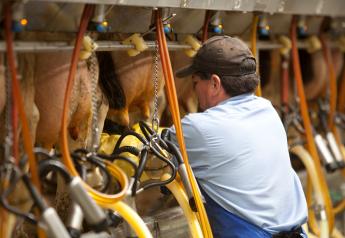Association Update: NMC Develops Cowside Diagnostic Tool

National Mastitis Council (NMC) provides a forum for education and international exchange of information related to udder health, milking management, milk quality and milk safety. Resource materials, such as the new Teat Condition Portfolio (unveiled at the 2018 annual meeting held earlier this year), fact sheets and books, play a key role in educating NMC members and other milk quality advocates regarding udder health tools, trends and research.
The Teat Condition Portfolio (TCP) is a user-friendly tool that helps individuals evaluate teat health cowside. An online resource, TCP contains more than 250 images of various teat conditions.
“The Teat Condition Portfolio provides a quick cowside assessment of environmental, infectious and milking machine-induced teat conditions,” says Keith Engel, past chair of NMC’s Teat Health Committee. “Quick assessment leads to early application of appropriate action or future preventive measures – allowing dairy producers to increase profitability.”
Online resource replaces CD
Prior to releasing TCP, NMC sold a compact disc (CD), developed by Teat Club International in the 1990s, which contained various teat health images. As a CD, users found it challenging to update and use cowside. Plus, several of today’s computers do not include CD drives.
“We overcame these challenges with the new online resource,” said Engel. TCP can be used cowside via a smartphone, tablet or computer, and can be updated as soon as new research, data and/or images become available. “Any NMC member can submit new TCP information and/or photos.” If approved by the Teat Health Committee, TCP will be updated accordingly.
Search images or by key word
Easily searchable by key word, TCP allows users to go immediately to the teat symptoms that match what they are seeing. Or, users can merely click through the images until they find a scenario that matches the teat ailment they are viewing in real time, cowside. Primary TCP users include veterinarians, udder health specialists, dairy producers, dairy herd managers, milking machine dealers, milk quality consultants, dairy extension specialists and milking parlor managers.
TCP’s images and key words are categorized under four broad topics – Environmental-induced Changes, Infections (non-environmental-induced changes), Milking Machine-induced Changes and Typical Range of Teats. In addition, TCP provides a Resource Library, which includes peer-reviewed, scientific papers regarding teat health, and a teat-scoring worksheet.
“Having the Teat Condition Portfolio available online to NMC members is a huge asset to all those working with teat health,” said Engel. “We are pleased with the benefits NMC members are reaping from this tool to help diagnose and improve teat health on dairy farms.”
Members find value in cowside tool
In just the first few months, nearly 1,000 NMC members have accessed TCP. “We’ve received outstanding feedback on TCP,” said Engel. “Cowside access makes it so easy to use and helpful in diagnosing teat health challenges.”
NMC’s Teat Condition Portfolio is a members-only benefit. Thus, only NMC members can access this online resource. Annual NMC individual membership costs $165 (U.S. dollar) and annual NMC student membership costs $25. To learn more about NMC membership benefits, go to the membership web page at: www.nmconline.org/membership/#membership-types.
New fact sheet on MALDI-TOF
In addition to TCP, NMC added the “Milk Bacteriological Analysis Using MALDI-TOF Technology” Fact Sheet to its resource library. This fact sheet describes Matrix Assisted Laser Desorption/Ionization-Time of Flight Mass Spectrometry (MALDI-TOF) and explains current practices being followed by diagnostic laboratories for reporting results generated using MALDI-TOF.
One advantage of MALDI-TOF, compared to other microbiological identification methods, is that it results yield genus (e.g., Staphylococci) and species (e.g., aureus) level identification in one single and rapid (less than 60 seconds) analysis. Furthermore, MALDI-TOF technology allows more bacterial isolates to be rapidly and accurately identified to species level.
MALDI-TOF Mass Spectrometry, proven to provide consistent, accurate and rapid identification of bacteria, fungi and mycobacteria, is now widely used in veterinary microbiology laboratories. One powerful feature is its ability to expand and share databases. As information is added to these databases, more bacteria will be identified to the species level.
Interested individuals can access the MALDI-TOF Fact Sheet, for free, on the NMC website (www.nmconline.org) under the Resources tab.
Updated books
Recently updated NMC books include the Laboratory Handbook on Bovine Mastitis and Current Concepts of Bovine Mastitis (CCBM). Both books are available for purchase on the NMC website (www.nmconline.org/publications). NMC members receive a discount on all publication purchases.
The third edition of the Laboratory Handbook on Bovine Mastitis discusses the basic theories of microbial culture, mastitis diagnosis and pathogens, laboratory procedures and molecular pathogen diagnosis methods. New chapters address molecular techniques, mycoplasmas and on-farm culture systems.
The fifth edition of CCBM discusses the basic theories of mastitis control, with updates based on new knowledge gained and technologies developed since the last edition (1998). CCBM includes information, photographs and illustrations, regarding intramammary pathogen sources and transmission, the course of mastitis and mastitis control and treatment methods. In addition, it contains the latest practices to help milk quality professionals prevent, control and treat mastitis. The book also includes a glossary and index.
Sidebar
NMC Annual Meeting Stipends for Veterinarians
NMC offers 20, $100 stipends for first-time attendees (veterinarians and dairy producers) to defer expenses to attend the NMC Annual Meeting. The 2019 NMC Annual Meeting will be held Jan. 29-Feb. 1, in Savannah, Ga. NMC’s short courses and general sessions provide RACE-approved continuing education credits for bovine veterinarians.
Schedule at a Glance
January 29 – Dairy Farm Tour
January 30 – Short Courses
January 31-February 1 – General Session







